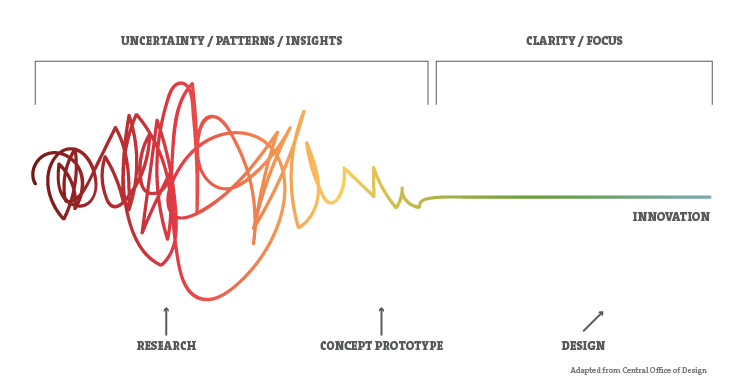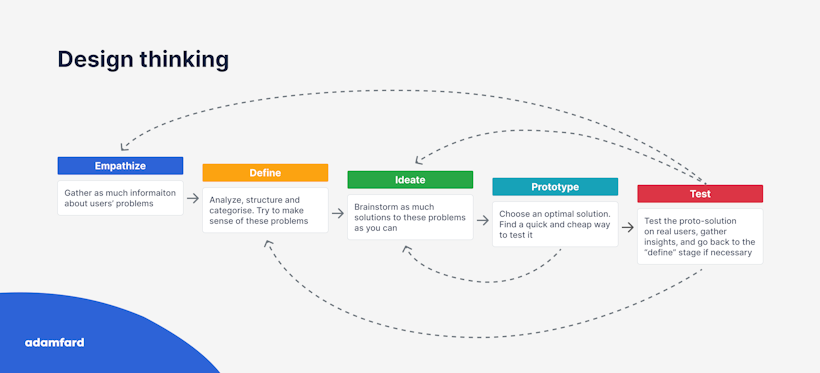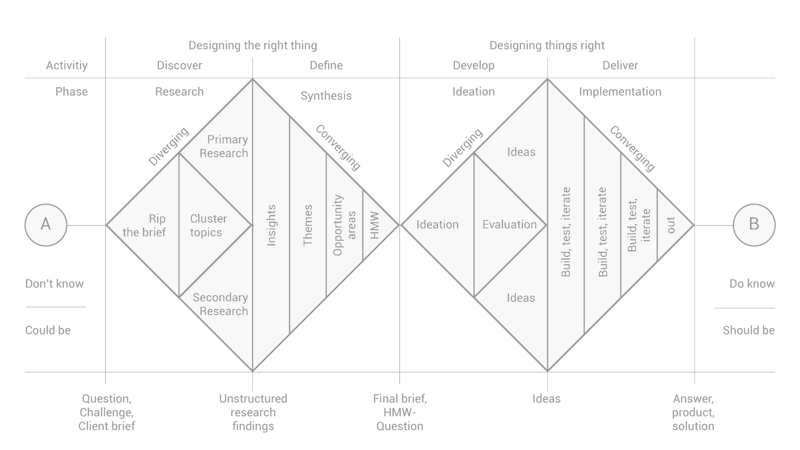Design Thinking is a vital framework in the modern business ecosystem. It’s an extremely efficient way of solving pressing product-related issues. While originally being a way of guiding design work, it has been adopted by a wide array of professionals.
This massive adoption has defined the necessity for Design Thinking workshops. They allow teams to empathize with the end-user, embrace a user-centric approach, and outline common goals.
However, the success of such workshops strongly depends on their planning and organization. This is precisely what this article is about. We’ll take a closer look at some recommendations regarding the structure of a Design Thinking workshop, as well as some small tips to ensure that things go smoothly.
Let’s get right into it.
PS. If you happen to consume content in the video form easier, AND you're a fan of John Snow, we have a treat for you. In this video, we'll explain design thinking through John's life.
What’s Design Thinking?
Providing a single all-encompassing definition of design thinking can be a demanding task. Therefore, it’s best to focus on its central functions in doing so.
Design thinking is a complex of activities that aim at understanding users, redefining problems into solutions, and developing concepts.
Design Thinking aims to:
Stimulate a more user-centric approach;
Enhance communication and understanding throughout the team;
Make product development more efficient while boosting the quality of the end-product;
Establish clear goals;
Prioritize tasks;
Create business value;
The grand scheme of things
Let’s look at Design Thinking workshops in the grand scheme of the design process.
One thing that is common among all design projects is lots of uncertainty — and that’s what such workshops aim to resolve.
This uncertainty stems from a variety of important questions like “Is there a demand for the X feature?” or “Is our current design usable?”. While such questions do have tried-and-true ways of answering them, they often demand an innovative approach.
That’s where Design Thinking workshops come into play.

Although design thinking has a lot of applications, they usually boil down to the following steps:

Think of these workshops as activities that help integrate Design Thinking as a process into the team’s workflow.
Preparing the workshop
Now that we’ve touched on the value of Design Thinking workshops and their purposes, let’s go over the steps of preparing one:
1. Planning
Ensuring that your workshop is adequately organized is an essential part of its success. One of the central parts of proper organizing revolves around defining clear goals — start by establishing why this workshop is necessary and what it aims to achieve.
Here are a few critical questions you need to answer before you select a date for your workshop:
Why is this workshop necessary?;
What is the expected outcome?;
What is the workshop agenda?;
Who needs to attend?;
Another crucial part of your workshop prep is dealing with logistics. While it’s not a very complicated process, it can be time-consuming and unforgiving if disregarded. Make sure to have your templates set up, invites to all the participants sent, and so forth.
By the way, the tool that we personally use most often for workshops is Miro. The free version is more than enough to have a killer workshop.
2. Easing into it
Great! So you’ve done all the housekeeping for the workshop, let’s get down to the first practical steps.
Kick off the meeting by covering a series of formalities.
Here they are:
Once the call or meeting starts, make sure to introduce the participants to each other. This will ensure that everyone is acquainted and provide them with essential context regarding the type of specialists participating;
Remind the participants what the purpose of the workshop is. Starting the workshop by announcing its goals will help set the right direction for it from the very beginning;
Remind the participants about the workshop’s agenda and its structure. This will help them gather a better understanding of the time constraints and the activities ahead;
Encourage the participants to have their cameras turned on. Otherwise, the risk of them getting distracted is huge. Even with a camera on, there's a temptation to check e-mail, slack, or Instagram. Therefore, to ensure the highest participant engagement insist on turning the cameras on.
You may also mention a few words of the meeting ethics, such as muting the microphone when not speaking, saying your name before you say anything else, and putting away participants' mobile devices, etc.
3. Icebreaker
It’s not always the case that team members are personally acquainted, especially if it’s a distributed team. Working on the same team hardly guarantees that team members have managed to build strong interpersonal relationships.
To mitigate this issue, consider incorporating an icebreaker activity. This will help partially eliminate boundaries between the participants and help them express their opinions more comfortably.
4. Explain Design Thinking
It’s always a good idea to acquaint the workshop’s participants with the fundamentals of Design Thinking ahead of time. Plus, it never hurts to reiterate the central tenets before you kick things off. This will help ensure that everyone is on the same page.
5. Empathizing with the user
This is where the real work begins. Building empathy with the end-user can take on many forms. If you already have collected some data on your users, feel free to share it. Alternatively, you can ask the participants to brainstorm potential problems.

6. Settling on a single problem
Depending on the amount of research done, you might have already established the problems for the workshop at hand. Alternatively, identifying the above issues could be one of the topics on the workshop’s agenda. Whatever the status is, it’s imperative to focus on one or a few specific points at a time.
7. Come up with solutions
Once you’ve established the most pressing issues that will be discussed at the workshop, brainstorm a variety of solutions to them.
Notice how design thinking involves alternating between diverging and converging thinking. We could map out the whole process as follows:

Thinking of the whole process in this way will help you better understand it.
Also note, that these workshops almost always require a facilitator. The facilitator, in this case, is the person responsible for keeping the workshop on point, helping it adhere to the agenda, and organizing it.
Design facilitation is an entirely different area of expertise in its own right. If you’ve never worn the hat of a workshop facilitator, consider applying some of the Design Thinking principles to the process itself. Be user-oriented in the way you approach the process and don’t hesitate to ask for feedback.
What’s next?
Once you’re past the ideation part of the Design Thinking workshop, it’s time to start prototyping and testing. The solutions you’ve gathered should be organized and prototyped to the degree that allows testing the solutions’ viability. As a result, you’ll be able to meaningfully incorporate your findings into new solutions for the product.
The bottom line
Design Thinking workshops are a constructive way of helping your team find creative and user-oriented solutions to design-related issues. Here, diligent prep work is your best friend, and focusing on a narrow list of issues is the key to success.





